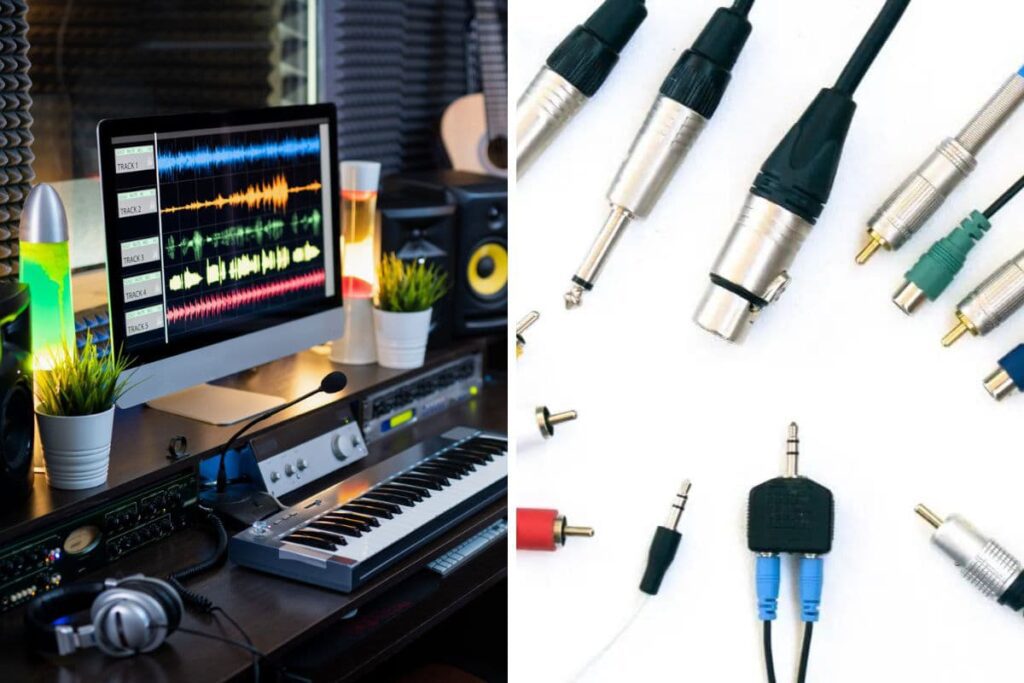You probably know that you need cables to set up studio monitors. However, figuring out which cables you need are included in the packaging when you purchase a studio monitor can be tricky because every brand is different. So, do all studio monitors come with cables?
Not all studio monitors come with cables; most only come with power cables. In most cases, users must purchase other necessary cables like the XLR, TRS, RCA, and digital optical cables separately. However, a few brands include the power cable plus other basic cables, especially the RCA types.
The rest of the article will explain the cables you can use to connect your studio monitors and how many are included in the packaging. I’ll also cover a few commonly asked questions about today’s discussion to help you understand everything you need about studio monitors and how to hook them up.
Table of Contents
- What Cables Do You Need To Hook Up Studio Monitors?
- What Cables Do Studio Monitors Come With?
- Do Cables Types Matter for Studio Monitors? PAA
- How To Connect Your Studio Monitors
- Conclusion

What Cables Do You Need To Hook Up Studio Monitors?
Before hooking them up to a chosen device, you will need XLR, TRS, or RCA cables depending on your studio monitors and the sound you want to produce. Also, you will have to get power cables and digital optical cables.
To get a better understanding of these cables, let’s independently talk about each one of them.
XLR Cables
These are balanced cables with three pins that use analog connections to transmit an audio signal from a musical device to the monitors using an electric current.
Depending on your monitor type, you may have to use only one connector or multiple. These cables are widely used because they prevent interference from your surroundings.
TRS Cables
These jack cables also remove or minimize interference to the sound signal. You can use them to get a stereo output, providing a natural sound.
Remember that these can only be used on studio monitors with TRS inputs or those with both TRS and XLR connections.
RCA Cables
Although these cables are old-fashioned and not popularly used, some speakers still come with inputs that require their usage. They have white and red plugs, which you can use to connect CD players, smartphones, and record players to your studio monitors.
Since RCAs are unbalanced cables, you risk getting a distorted signal as they can easily pick up interference from your environment.
Power Cables
You need power cables to plug into your devices before inserting them into a socket to operate your electronics. These cables may have three-pin cords or two, so you should buy the type you prefer that can fit in your sockets.
Also, buy cables with the correct voltage to run your devices without short-circuiting.
Digital Optical Cables
These cables can only work on studio monitors with digital connections to send stereo sound between devices. With these cords, you are assured of a cleaner sound because they transfer audio signals via a binary code that prevents interference from other electrical devices.
When you use digital optical cables, you can transmit a maximum of 8 signals from your preamplifier to the audio interface, which then sends the sound to the monitors.
What Cables Do Studio Monitors Come With?
Having looked at the various types of cables, you would need to hook up a studio monitor, let’s find out how many of those are included in the product packaging.
Unfortunately, most studio monitors only come with power cables. The other cables in the list above typically have to be purchased separately.
But as with any rule, there are exceptions. Some sellers include a few basic cables in addition to the power cable.
For instance, this PreSonus Eris E3.5-3.5″ pair (available on Amazon.com) comes with RCA cables. It also comes with a speaker cable for connecting the two speakers. Of course, the power cable is included.
Ultimately, it all comes down to who you buy from. So if you don’t want to purchase cables separately, you might want to look around to find a seller or brand that includes all or most of the cables you need to hook up your studio monitor.
Do Cables Types Matter for Studio Monitors? PAA
The type of cables you choose to hook up your studio monitors matters because some power cords, like the unbalanced ones, can allow noise and other interferences to distort your sound mix. This can make it difficult for you to analyze the music you produce for any mistakes so that you can fix them.
I would advise using balanced cables, such as TRS and XLR, or getting digital optical cables that are insusceptible to noise interference.
How To Connect Your Studio Monitors
You will need an audio interface and computer to connect your microphone and other musical instruments on top of the XLR, TRS, or RCA cables to send music to the monitors.
Once you have all the essentials, you can connect your studio monitors using the following steps:
- Turn down all the volume and EQ knobs before you connect your monitor speakers. If you turn on these devices when the volume is way up, you can damage the monitors and your hearing.
- Use a male-to-male Type-A or B USB cable to connect your audio interface to the computer. When your computer recognizes the interface, the operating system will automatically install its correct drivers. If it doesn’t, visit your audio interface’s manufacturer support page online to learn how to download and install these drivers.
- If you have passive monitor speakers, use a speaker wire or RCA cable to connect them to an amplifier. The reason for doing this is to enable it to effectively power the monitors since your interface cannot provide enough voltage to passive studio speakers. You can skip this step with active studio speakers with an in-built amplifier.
- Connect your guitar or microphone to the audio interface to start recording a mix before hooking the studio monitors to the interface. Use TRS, XLR, or RCA cables, depending on the output ports of your audio interface. After connecting both devices, correctly tune the volume on your speakers and the EQ for excellent sound mix quality.
- Play a song on your computer and adjust the volume on the audio interface until you get the right volume. If the monitors fail to release any music, check your connections to ensure you fix them properly.
Other than properly connecting your studio monitors, you should also learn how to turn them off properly. Read my article to discover how to turn off your audio equipment. How To Properly Turn Off Your Studio Monitors
Conclusion
Although not all studio monitors come with cables because the manufacturing companies do not want to risk providing the wrong ones, you can buy these power cords for yourself. However, when purchasing them, ensure that you get the correct ones and that they are long enough to run between the devices.
- Review of the ALABS IRON MINI-WL: A Powerhouse Wireless Microphone - October 4, 2023
- What is a Saturator in Music Production: A Brief Explanation - May 11, 2023
- What Are Rotary DJ Mixers? An Overview - May 11, 2023
SoundStudiomagic.com is a participant in the Amazon Services LLC Associates Program, an affiliate advertising program designed to provide a means for sites to earn advertising fees by advertising and linking to Amazon.com. We also participate in other affiliate programs which compensate us for referring traffic.

